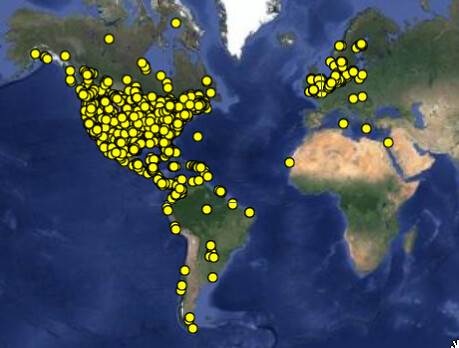Yup. The Motus network (map of stations below) has been expanding in central and south america and being able to deploy stations with just an omni (as is typical for LoRaWAN) vs. 3x 166Mhz 9-element Yagis would make it a lot easier to convince local researchers to go through the effort. I’m less plugged into the efforts in Africa so I don’t know what the status is there.
Understood. The one twist is that the real-world range tests I’m aware of transmit at max power, which I don’t expect to be able to do due to battery instantaneous power constraints. I expect to be 12dB-18dB down from what I believe you have in mind when you talk of 100 miles, so I’m looking at 1/8th-1/4 the range.
Yup. I have a 0.8g prototype that uses 433Mhz FSK, I’m here trying to figure out what parameters I should tweak to maximize my chances to make a successful 915Mhz LoRaWAN prototype.
Do you have any link, name, or keyword for me? I can find quite some stuff about vulture conservation in S.A. but not LoRaWAN. I am aware of a LoRaWAN project tracking vultures in Portugal/Spain by U of East Anglia, Miromico and Movetech (Characterisation of a new lightweight LoRaWAN GPS bio-logger and deployment on griffon vultures Gyps fulvus | Animal Biotelemetry | Full Text). The one S.A. mention I found is https://www.wur.nl/en/show/vulture-movement-ecology-and-preventing-their-poisoning.htm but no details and unclear whether LoRa or LoRaWAN, looks like the project may be still underway.
Something interesting is that from what I can tell the Portuguese project used a transmission strategy along the lines of what I tried to describe in my strategy #3: the trackers send what they call welcome messages periodically always asking for an ACK expecting that the majority go unheard/unacked. When they get an ACK they switch to upload mode and send a burst (relatively speaking) of messages (no DL requested) with the data stored on the tag. After some number of data messages they expect another ACK before proceeding (the paper is understandably sketchy about the details).
The tags are available down to 4g by Miromico, not clear whether that weight includes battery or is just the electronics. It’s also 2021 era tech and some things have improved since. I’m trying to see how far down I can push the weight and what the tradeoffs look like. Basically the lighter weight the tag the more species it applies to (the general guideline is that the tag must weigh less than 5% of body mass). Some of the current VHF/UHF tags used weigh 0.65g and go on song birds. Some tags even go down to 0.16g for hummingbirds and butterflies. Nope, I don’t expect to get there with GPS and LoRaWAN ![]()
Do you have any details or data for me?
WRT GPS I know that there are interesting recent improvements but have not been able to find real-world data or test myself (damn 24 hours per day limitation). But there are other ways to determine location in the context of bird migration: it’s not all about meter-level accuracy. The LR1121 listens to WiFi beacons (as I’m sure you’re aware), some tags listen to GSM beacons (not a great strategy in the US anymore but likely viable in the EU for a good while), and there’s the obvious localization obtained by knowing the coordinates of the gateway that received a packet (a bat tag project used SigFox plus GPS and found the data derived from SIgFox (gateway location + RSSI) to be very usable for a range of inquiries.
So far what I have gathered is:
-
The Portuguese vulture tracking shows that using LoRaWAN for the purpose is possible and they evidently used some perhaps unusual TX strategies. Their tags were way heavier than I’m looking for and while they talk about public LoRaWAN network I don’t believe they actually ended up connecting to any (a bit hard to tell in the paper).
-
The RX windows are a bigger power concern than I realized and I need to research that some more. The LoRaWAN std says RX2 is fixed and typ. SF12. Looks like that can be configured to SF9 on TTN. Dunno about EveryNet or others. Need to set up gw+node to try this out.
-
The CPU power consumption by the stack is something I haven’t considered. Sounds like LMIC may not be the way to go (MiniPill LoRa - STM32 Low Power Node - #33 by leo_korbee). Motivation to try it out, but first I have to figure out which stack to use, is MCCI Arduino LoRaWAN the easiest place to start using an stm32wle5?
Thanks for the pointers so far!
